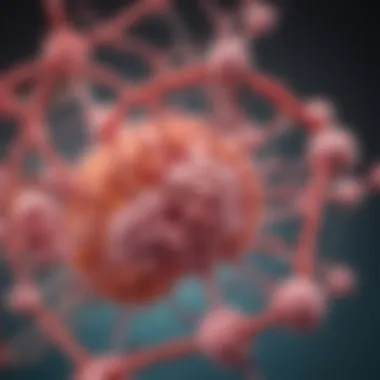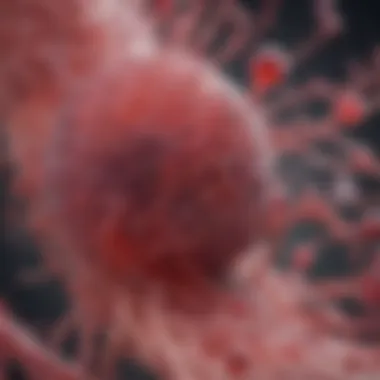Transglutaminase Sigma: Roles and Therapeutic Insights


Intro
Transglutaminase sigma, often simply referred to as TG2, is an enzyme that stands at the junction of multiple biological processes. It performs a key role in protein cross-linking, cellular signaling, and maintaining tissue integrity. Understanding the multifaceted functions of this enzyme is essential, not just for the sake of academic curiosity, but for its practical implications in health and disease. By diving into its biochemical properties, one can appreciate its importance across various biological systems.
The allure of TG2 lies in its complexity. On one hand, it facilitates crucial interactions among proteins, while on the other, it regulates a plethora of signaling pathways. This versatility makes transglutaminase sigma a significant topic of discussion among researchers and professionals alike.
In examining TG2, we will unravel its intricate mechanisms, explore its applications in therapeutic contexts, and delve into the regulatory mechanisms that govern its activity. Understanding this enzyme provides valuable insights for those in biological sciences, revealing both the fundamental and practical aspects of its functions.
Prelude to Transglutaminase Sigma
Understanding transglutaminase sigma is essential in grasping its wide-ranging influence on various biological systems. This enzyme doesn’t just play a peripheral role; it’s at the heart of many critical processes, including protein cross-linking and tissue remodeling. These functions make it pivotal for not only maintaining tissue integrity but also for cellular signaling. With the growing body of research focusing on transglutaminase sigma, it's clear that we are only scratching the surface of its potential and applications, particularly in health and disease contexts.
Definition and Classification
Transglutaminases are a class of enzymes that facilitate the formation of covalent bonds between proteins. These enzymes, including transglutaminase sigma, are categorized based on their structural and functional properties. Transglutaminase sigma, specifically, is classified under the transglutaminase family, which has several members, each playing distinct roles in tissue biology and physiology.
In simpler terms, you can think of transglutaminase sigma as a kind of molecular glue. This enzyme has the special ability to bind amino acids together, a process that is pivotal for the stabilization of protein structures. This cross-linking is not only crucial for protein stability but also influences various cellular processes. The classification helps in studying how different transglutaminases can be targeted for specific therapeutic applications, which is a rapidly evolving area of research.
Historical Context
The exploration of transglutaminases dates back several decades, though transglutaminase sigma itself received more focused attention in the late 20th century. Initial studies centered around the enzymatic activities of transglutaminases, leading to the discovery that they are not merely catalysts but also significant modulators of biological functions. Researchers began to realize that these enzymes could influence everything from blood coagulation to cell signaling pathways, making them integral components of the biological narrative.
As the science unfolded, a clearer picture emerged about transglutaminase sigma's roles. Unlike its better-known counterparts, such as tissue transglutaminase, which has been widely studied for its association with celiac disease and apoptosis, transglutaminase sigma has remained somewhat of a niche topic. Nevertheless, its importance is increasingly recognized in regenerative medicine and cancer research.
Biochemical Characteristics
Biochemical characteristics offer vital insights into how transglutaminase sigma functions at the molecular level. Understanding these characteristics helps in elucidating its role in various biological processes and its significance in health and disease. By delving into the details of enzyme structure and substrate specificity, researchers can better appreciate the potential applications of transglutaminase sigma in therapeutic contexts.
Enzyme Structure
Transglutaminase sigma exhibits a unique enzyme structure that plays a critical role in its functionality. Generally, the structure is composed of multiple domains, which contributes to the enzyme's stability and catalytic efficiency. This enzyme is characterized by a catalytic domain, which houses the active site responsible for substrate binding and catalysis. The enzyme's structure is also influenced by factors such as post-translational modifications, which can alter its activity.
The three-dimensional fold of transglutaminase sigma allows it to interact with a range of protein substrates, which is essential for its cross-linking properties. These interactions not only facilitate the formation of protein networks but also influence cellular processes like signaling and tissue repair. An interesting feature of its structure is the presence of a calcium ion-binding site. This binding can induce conformational changes in the enzyme, enhancing its activity when calcium is present, which is often critical in cellular environments.
Substrate Specificity
Substrate specificity is a key factor in understanding how transglutaminase sigma functions and its biological implications. A variety of proteins can be targeted as substrates, leading to diverse outcomes across different tissues and cellular contexts. The specificity of transglutaminase sigma arises from the unique properties of its active site, which allows it to recognize specific amino acid sequences that are characteristic of target proteins.
The implications of this specificity are profound. For instance, in wound healing, transglutaminase sigma modifies the extracellular matrix, thus stablizing tissue structure. On the flip side, improper activity can occur, leading to adverse effects such as fibrosis or impaired healing. The ability of transglutaminase sigma to preferentially cross-link certain proteins also suggests potential mechanisms for modulation of signaling pathways within cells.
In summary, understanding the biochemical characteristics of transglutaminase sigma—the intricate structure and its substrate specificity—opens the door for innovative therapeutic strategies. As technology improves, these insights will likely pave the way for new applications in medicine, particularly in the treatment of diseases where this enzyme plays a critical role.
"The study of enzyme structure and function is like peeling an onion; every layer brings us closer to the core of biological activity."
It is crucial for researchers and practitioners alike to remain aware of these biochemical nuances, as they directly impact the therapeutic relevance of transglutaminase sigma.
Mechanism of Action


Understanding the mechanism of action of transglutaminase sigma gives us insight into its essential role in various biological processes. This enzyme facilitates reactions that are pivotal for protein interaction and cellular functions. It acts primarily through the process of protein cross-linking, which is crucial for tissue strength and resilience. Without such mechanisms, tissues could be susceptible to damage and degradation, leading to various health issues.
Catalytic Mechanism Overview
In the realm of enzyme biology, a clear grasp of the catalytic mechanism is indispensable. Transglutaminase sigma catalyzes reactions by forming covalent bonds between the amine group of one protein and the carboxyl group of another. This process results in cross-linked proteins, enhancing the structural properties of tissues.
- Binding to Substrates: The enzyme first binds to its substrate through its active site, which has a specific structure suited for binding certain proteins. This specificity is what makes transglutaminase sigma unique; it interacts selectively with proteins like fibronectin and collagen.
- Formation of Enzyme-Substrate Complex: After binding, a transient enzyme-substrate complex forms. This complex undergoes a series of conformational changes, leading to a transition state that facilitates the reaction.
- Covalent Bond Formation: The actual catalytic reaction involves the formation of a covalent bond between the substrate's glutamine side chain and the enzyme's reactive site. This step is what enables the cross-linking of proteins, essential in many physiological processes.
- Release of Products: Post-reaction, the cross-linked proteins are released, allowing subsequent substrates to enter the active site and repeat the process.
In summary, the catalytic mechanism is a fine-tuned process that combines structural specificity with precise bio-chemical interactions.
Regulatory Mechanisms
The activity of transglutaminase sigma does not occur in a vacuum; it is intricately regulated through various mechanisms. Such regulatory systems ensure that the enzyme’s activity aligns with the physiological needs of the organism.
- Allosteric Regulation: This feature allows the enzyme’s activity to be modulated by the binding of effectors at sites other than the active site. Positive or negative effectors can increase or inhibit the enzyme's activity, respectively, displaying a balance akin to the yin and yang.
- Post-Translational Modifications: The enzyme can undergo changes after it is synthesized, such as phosphorylation or acetylation. These modifications often serve to enhance or diminish the enzyme's function in response to cellular signals.
- Inhibitors and Activators: Various endogenous compounds can also inhibit or activate transglutaminase sigma. For instance, the presence of calcium ions has been shown to significantly enhance its activity, linking it to more extensive signaling pathways.
"The precise regulation of transglutaminase sigma is as imperative to its function as the reactions it catalyzes."
Physiological Roles
Transglutaminase sigma plays a pivotal role in a plethora of physiological processes, acting as a linchpin in various biological systems. A thorough understanding of its physiological roles not only enriches the scientific narrative surrounding this enzyme but also provides insights into its potential applications in health and disease management. From tissue repair to cellular signaling, the functions of transglutaminase sigma are essential yet meticulously intricate.
Tissue Repair and Remodeling
Transglutaminase sigma is deeply involved in the complex tapestry of tissue repair and remodeling. When tissue injury occurs, the body embarks on a healing journey, which demands the orchestration of multiple cellular events. This enzyme contributes to the healing process by facilitating protein cross-linking, which enhances the structural integrity of the extracellular matrix. As the scaffolding for tissue, the extracellular matrix is vital for supporting cells and promoting wound healing.
- Key Functions in Tissue Repair:
- Collagen Stabilization: Transglutaminase sigma modifies collagen fibers to promote their stability. This stability is crucial because damaged or improperly arranged collagen can lead to scarring or chronic tissue injuries.
- Cell Adhesion Promotion: By modifying proteins that mediate cell adhesion, the enzyme helps cells migrate to the wound site, establishing a functional tissue interface.
- Cytokine Regulation: Transglutaminase sigma can influence the local inflammatory response, an essential element during the repair process. It helps modulate cytokine activity, guiding the healing process by promoting an appropriate inflammatory response.
These functions are indispensable, whether you are talking about skin repositioning after a cut or the realignment of tissues in internal organs after surgical interventions. Without effective action from transglutaminase sigma, these processes could be stunted, leading to incomplete healing or excessive scarring.
Cellular Signaling Pathways
Transglutaminase sigma also plays a significant role in cellular signaling pathways that help regulate various physiological responses. This enzyme acts not just as a facilitator of physical tissue integrity but also serves as a communicator among cells, effectively translating biochemical messages into cellular actions.
In particular, transglutaminase sigma may be involved in the following aspects of cellular signaling:
- Signal Transduction: By modifying signaling proteins, transglutaminase sigma can help in the activation or repression of pathways that dictate cell survival, differentiation, and proliferation.
- Influencing Apoptosis: Studies suggest that this enzyme can impact programmed cell death processes, further emphasizing its importance in maintaining cellular homeostasis.
- Integrating Signals: Transglutaminase sigma acts as a hub for integrating signals from various sources, effectively directing cellular behavior in response to changes in the environment.
"Understanding the multifaceted roles of transglutaminase sigma enables researchers and healthcare professionals to look for new avenues for therapeutic interventions, especially in wound healing and regenerative medicine."
As research continues to unveil the pathways influenced by transglutaminase sigma, the potential for targeting these processes in therapeutic contexts becomes more apparent. This deep dive into its physiological roles not only underscores the enzyme's significance but also highlights opportunities for innovative treatments that harness its unique biochemical properties.
Transglutaminase Sigma in Disease
Transglutaminase Sigma (TG2) is not just an enzyme roaming aimlessly around the body; it's a critical player in various pathological conditions. Its remarkable versatility can tilt the balance between health and disease. Understanding TG2's role in disease states unveils new possibilities for interventions, making this topic vital for students, researchers, educators, and professionals in biosciences.


Role in Inflammation
Inflammation is a double-edged sword. It can protect against injury and infection, yet when it goes haywire, it can lead to chronic ailments. TG2 is intricately involved in this process. During inflammation, TG2 is often upregulated, influencing various aspects like cell proliferation and migration.
Research shows that TG2 can facilitate the cross-linking of proteins within inflamed tissues. This promotes tissue stability but may also lead to a stiffening of the extracellular matrix, which can exacerbate inflammation and fibrosis over time. In conditions like rheumatoid arthritis and inflammatory bowel disease, TG2's activity can significantly contribute to the progression of these disorders, turning what should be a temporary response into a relentless cycle.
"Understanding TG2 in inflammation could lead us to novel anti-inflammatory strategies tailored to individual conditions, enhancing patient outcomes."
Implications in Cancer Progression
In the realm of oncology, TG2 is emerging as a disturbing player. Its role in cancer progression is multifaceted. On one hand, TG2 contributes to tumor cell survival by helping cancer cells resist apoptosis. On the other hand, it promotes metastasis by facilitating cell adhesion and migration through extracellular matrix degradation.
In various cancers, including pancreatic and colorectal, the expression levels of TG2 are often elevated. Studies indicate that high TG2 activity correlates with poor prognosis. This intertwined relationship denotes TG2 as a potential biomarker for cancer progression and a therapeutic target. The exploration of TG2 inhibitors could become a promising avenue for future cancer therapies.
Associations with Neurodegenerative Disorders
Neurodegenerative disorders such as Alzheimer's and Parkinson's disease present a complex landscape of challenges from a pathological perspective. Emerging evidence indicates that TG2 is implicated in the pathological processes of these diseases. For instance, TG2 can contribute to the formation of protein aggregates, a hallmark of neurodegeneration.
This aggregation process disrupts neuronal function and contributes to cell death. Additionally, TG2's involvement in the modulation of various signaling pathways, including those related to neuroinflammation, poses new questions about its role in disease mechanisms. Thorughout this exploration, inhibiting TG2's activity is being considered to slow down progression, suggesting potential therapeutic strategies that warrant further investigation.
The implications of TG2 in diseases like these could reshape our future approaches to treatment and intervention, offering hope where there was little before.
Therapeutic Applications
Transglutaminase Sigma has emerged as a focal point in the field of therapeutic research due to its diverse roles in cellular processes and its potential as a target in various treatments. The enzyme not only participates in protein cross-linking and remodeling but also interacts with crucial signaling pathways, which makes it a significant player in both health and disease. Understanding its therapeutic applications can provide insights into innovative treatments for various conditions ranging from inflammatory diseases to cancer.
Drug Development Targeting Transglutaminase Sigma
The landscape of drug development is continuously evolving, and targeting transglutaminase sigma represents a promising avenue. This enzyme has arrived under scrutiny for its involvement in several pathologies, primarily due to its capacity to modify proteins, thereby influencing cell behavior and signaling.
Key aspects in drug development involving transglutaminase sigma include:
- Target Specificity: By honing in on transglutaminase sigma, researchers can design agents that specifically inhibit or enhance its activity. This specificity could lead to fewer side effects compared to broader-spectrum drugs.
- Validation of Biomarkers: As transglutaminase sigma levels can be linked to various diseases, it could serve as a biomarker for the efficacy of new treatments. Monitoring these levels could provide actionable insights during clinical trials.
- Combination Therapy Possibilities: Using transglutaminase sigma inhibitors in conjunction with existing therapies may enhance their effectiveness. For instance, pairing these agents with traditional cancer therapies could help in overcoming resistance mechanisms.
In the context of drug development, transglutaminase sigma could pave the way for next-generation compounds that address unmet medical needs. This approach underlines the potential of driving innovation through a better understanding of enzymatic functions.
Potential for Gene Therapy
Gene therapy is a frontier in biomedical science, presenting the ability to treat or even cure diseases at the genetic level. The exploration of transglutaminase sigma's functions opens pathways for its manipulation in gene therapy strategies.
Considerations when looking at transglutaminase sigma in gene therapy include:
- Gene Editing Technologies: Utilizing CRISPR or other gene editing techniques to alter the expression of transglutaminase sigma can lead to altered cellular responses. For instance, increasing the expression in tissue repair scenarios could enhance healing processes.
- Delivery Mechanisms: Effective delivery of gene therapies remains a challenge. Innovative delivery systems, possibly utilizing nanoparticles, could ensure that therapeutic genes reach target cells efficiently.
- Patient-Specific Therapeutics: The potential for tailoring therapies based on individual genetic markers associated with transglutaminase sigma activity could revolutionize treatment paradigms. This personalized approach ensures that therapies are more aligned with the unique pathological context of each patient.
"Transglutaminase sigma not only modifies proteins but plays a crucial role in cellular dynamics, making it a viable target for innovative therapies in the age of precision medicine."
For further reading, you can explore resources on Wikipedia and Britannica.
Research Methodologies


Research methodologies form the backbone of scientific inquiry, shaping how we understand the complex roles of transglutaminase sigma. Choosing the right approach enables researchers to explore this enzyme's functionalities and interactions with clarity and precision.
Understanding the significance of specific methodologies in studying transglutaminase sigma can greatly impact the outcomes of the investigations. With various experimental techniques at their disposal, researchers can unravel the enzyme's role in both normal physiology and pathological conditions, enhancing our collective knowledge about cellular processes. Factors to consider include the accuracy of the chosen methods, their applicability in different biological contexts, and how they can be scaled or adapted as required by changing research demands.
"The choice of research methodology not only impacts the results but often defines the path of discovery itself."
Experimental Techniques Involved
When investigating transglutaminase sigma, a range of experimental techniques are utilized. Each method has its own strengths, enabling researchers to probe various aspects of the enzyme's function. Here are a few critical techniques:
- Western Blotting: This technique allows for the detection of transglutaminase sigma in complex protein mixtures. By separating proteins via gel electrophoresis and transferring them onto membranes, researchers can visualize the protein using specific antibodies.
- Enzyme Activity Assays: These assays measure the enzyme's catalytic activity by assessing its ability to cross-link proteins in vitro. This kind of quantification can give insight into how transglutaminase sigma functions under various conditions.
- Immunofluorescence Microscopy: This method lets scientists visualize the distribution and localization of the enzyme within cells. Fluorescently labeled antibodies specific to transglutaminase sigma can illuminate its presence in tissues or cells, providing spatial context to its activities.
- Mass Spectrometry: Mass spectrometry can be employed to analyze protein interactions and post-translational modifications mediated by transglutaminase sigma. It provides detailed information regarding substrate specificity and protein alterations that occur during enzymatic action.
Model Organisms Used in Studies
To grasp the full breadth of transglutaminase sigma's role, various model organisms are used in research, each simulating human biological systems in distinct ways. These model organisms help bridge the gap between in vitro findings and in vivo relevance:
- Mice: As often the choice for mammalian studies, genetically modified mice expressing or lacking transglutaminase sigma can provide insights into the enzyme's physiological and pathological roles, particularly related to tissue repair and diseases.
- Drosophila Melanogaster (Fruit Fly): The simplicity of Drosophila, combined with powerful genetic tools, makes it an ideal organism to study basic biological processes and developmental pathways influenced by transglutaminase sigma.
- Zebrafish: This transparent organism is excellent for observing developmental events in real-time. Researchers can use it to study transglutaminase sigma's role in embryonic development and tissue regeneration.
- Yeast Models: Fungi like Saccharomyces cerevisiae can be engineered for easier studies on protein interactions involving transglutaminase sigma, shedding light on basic biochemical interactions in a controlled environment.
By employing robust and varied research methodologies, scientists can paint a detailed picture of transglutaminase sigma's functions and interactions across different biological contexts.
Future Directions
Exploring future directions in transglutaminase sigma research holds significant importance. This enzyme is key in a multitude of biological processes, and its intricate mechanisms of action continue to unfold. The understanding and application of transglutaminase sigma affect various fields, including medicine, biochemistry, and cellular biology. As researchers delve deeper into its functionalities, the potential benefits might lead to innovative therapeutic approaches and enhanced disease management strategies.
Emerging Research Trends
Research trends around transglutaminase sigma are appearing at a rapid pace. Many studies are focusing on the enzyme's role in tissue regeneration and wound healing, suggesting that it could play a pivotal part in advancing regenerative medicine. Here’s what’s currently in the spotlight:
- Molecular Mechanisms: More efforts are being channelled into understanding the specific molecular pathways regulated by transglutaminase sigma. Studies are revealing its involvement in cellular processes like apoptosis, which might point towards its roles in various diseases.
- Protein Cross-linking: The intricacies of protein interactions facilitated by transglutaminase sigma are capturing the attention of scholars. Insights into how this catalytic process contributes to structural integrity in tissues could fundamentally shift current therapeutic paradigms in treating degenerative conditions.
- Monitoring and Biomarkers: With advancements in molecular biology techniques, the potential emergence of transglutaminase sigma as a biomarker for certain diseases is promising. This could lead to earlier diagnostics and tailored treatment plans in healthcare.
Innovative Therapeutic Strategies
The road ahead offers several avenues for innovative therapeutic strategies that leverage the knowledge of transglutaminase sigma. Possible applications could include:
- Gene Editing: As CRISPR technology and similar gene-editing tools progress, targeting the genes responsible for transglutaminase sigma production may enhance its therapeutic functions. Fine-tuning its levels could be a game changer in sustaining tissue health.
- Small Molecule Modulators: The identification of small molecules that can specifically enhance or inhibit transglutaminase sigma activity could lead to novel treatments for inflammatory diseases or cancer. These strategies might forge pathways toward more dynamic and effective drug designs.
- Therapeutic Enzyme Replacement: A long-term vision could involve the development of enzyme replacement therapies, especially for conditions where transglutaminase sigma levels are deficient. Such approaches may alleviate symptoms and promote better health outcomes.
"Advancements in transglutaminase sigma research pave the way for groundbreaking therapeutic options that could revolutionize healthcare practices."
Epilogue
In the intricate field of cellular biology, the role of transglutaminase sigma cannot be overstated. This enzyme, which facilitates critical processes like protein cross-linking and cellular signaling, is foundational to understanding various physiological and pathological conditions. By synthesizing knowledge accumulated throughout this article, we highlight how transglutaminase sigma is not just a passive player; it dynamically interacts with other biomolecules, influencing tissue integrity and cellular functions.
Summary of Key Findings
The evaluations presented consolidate several pivotal aspects:
- Biochemical Characteristics: Transglutaminase sigma exhibits unique substrate specificity, emphasizing its versatility in diverse biological contexts.
- Mechanism of Action: The enzyme’s catalytic mechanisms involve intricate regulatory pathways, underscoring its importance in maintaining cellular homeostasis.
- Physiological Roles: It plays vital roles in tissue repair and remodeling, and it is intertwined with various cellular signaling pathways that facilitate communication within cells.
- Disease Implications: The enzyme has been implicated in inflammation, cancer progression, and neurodegenerative disorders, indicating its potential as a biomarker and therapeutic target.
- Therapeutic Applications: Ongoing research is paving the way for innovative therapeutic strategies that harness the enzyme's properties, while the potential for gene therapy offers exciting prospects for future interventions.
Final Remarks on Transglutaminase Sigma
In closing, the expansive reach of transglutaminase sigma within biological systems is a testament to its fundamental role in life sciences. Understanding its multifaceted functions can inform therapeutic approaches, particularly in the context of diseases where this enzyme plays a significant part. Thus, continued research not only enriches the field of biology but holds promise for targeted treatments that can alter disease trajectories.
As the scientific community forges ahead, it becomes increasingly clear that transglutaminase sigma is more than merely a subject of study; it represents a crucial interface linking various biological phenomena, promising to unlock new pathways in both research and clinical practice. The insights gained from this enzyme will undoubtedly contribute to advancing our grasp of complex biological systems and enhance the strategic goals of therapeutic development.
"The deeper we dive into the molecular machinations, the clearer it becomes that the lines between health and disease are often quietly drawn by the actions of enzymes like transglutaminase sigma."







